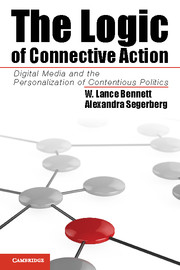Book contents
- Frontmatter
- Contents
- List of Tables and Figures
- Acknowledgments
- Introduction
- 1 The Logic of Connective Action
- 2 Personalized Communication in Protest Networks
- 3 Digital Media and the Organization of Connective Action
- 4 How Organizationally Enabled Networks Engage Publics
- 5 Networks, Power, and Political Outcomes
- 6 Conclusion
- Bibliography
- Index
4 - How Organizationally Enabled Networks Engage Publics
Published online by Cambridge University Press: 05 June 2014
- Frontmatter
- Contents
- List of Tables and Figures
- Acknowledgments
- Introduction
- 1 The Logic of Connective Action
- 2 Personalized Communication in Protest Networks
- 3 Digital Media and the Organization of Connective Action
- 4 How Organizationally Enabled Networks Engage Publics
- 5 Networks, Power, and Political Outcomes
- 6 Conclusion
- Bibliography
- Index
Summary
The preceding chapters analyzed protest actions mobilized by different types of connective action networks. As defined in Chapter 1, connective networks rely on digital technologies to help people personalize their political participation and focus the attention of policy makers and broader publics on hotly contested issues. Beyond taking to the streets to display popular concern, there are many ways in which activists and organizations seek to promote their causes in public. Organizations and concerned citizens spend time and resources helping to educate people about issues and showing them how to incorporate acts of issue awareness into everyday life. Issue advocacy organizations also help citizens join in more collective forms of political influence, such as petitions, campaigns, election canvassing, and networking with friends. In undertaking such public action, organizations often form networks with others to coordinate and amplify their political strategies. Such networks may be more or less (or not at all) connective. This chapter examines the conditions under which organizations do or do not form connective action networks, the very different ways in which those networks can be organized, and how different organizational patterns reflect the role of digital media in enabling personalized public involvement in large-scale action over time.
- Type
- Chapter
- Information
- The Logic of Connective ActionDigital Media and the Personalization of Contentious Politics, pp. 114 - 147Publisher: Cambridge University PressPrint publication year: 2013



